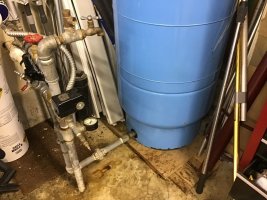Rechrgd
New Member
My home was built in 1985. When the well system was installed they simply put a tee in the line running underground to the house and ran a single pipe up to the pressure tank in the shop. The only shutoff valve for the house is in the crawl space and a pain to even get to now that I’m in my ‘70’s. If I was to put a valve at the tank, I assume closing it would drive the pressure switch crazy and burn out the pump. Changing plumbing at the tank or house would be quite involved and expensive. I could just go ahead and install a valve at the tank and shut off the power to the pump before closing it. But, it would be too easy for someone to shut the valve off and not the power when I’m not around. I have a strong electrical background. I would like to install a normally closed contactor in the circuit feeding the pump. I want to activate the contactor via a micro switch on the shutoff valve at the tank. So, if someone was to just shut the valve, the power would automatically be shut off to the pump. I’m envisioning a ball valve with the switch installed as a unit. I know that these things exist in the process control world, but are built for liquids and pressures that make them unaffordable for this application. Surely something like this must exist in the plumbing world that would be reasonably priced, but I can’t anything. I don’t really want to just rig up something. Does anybody know of a source for such a valve or should I just bite the bullet and call a plumber?



